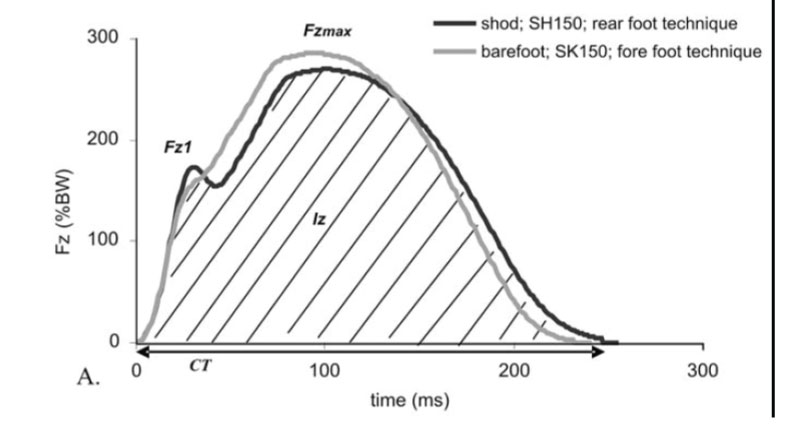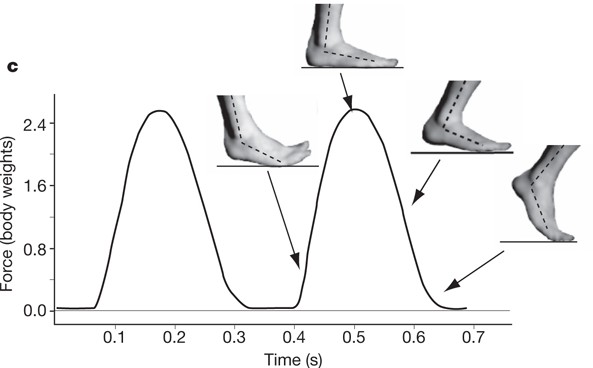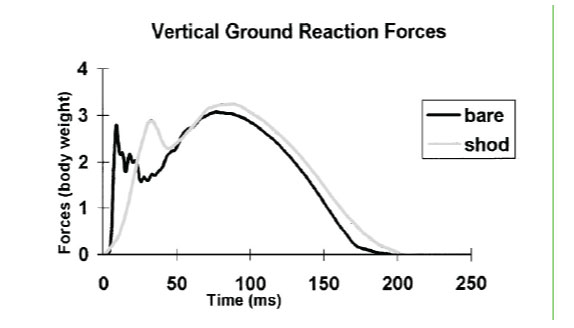Barefoot, forefoot strike and heel strike - a biomechanics summary
Audience: Runners and therapistsPurpose: To summarize the biomechanics of running strike pattern and shod conditions
I feel like in the blogosphere and the popular running media that there is a love affair with all things barefoot. Barefoot running is associated with forefoot striking and there appears to be changes in the biomechanics associated with alteration in running form when compared with heel striking. However, the research gets presented as if it is very neat in tidy when in fact it is quite murky. This post is a work in progress. It attempts to summarize some of the work comparing barefoot running with shod running and the work that compares forefoot striking and rearfoot striking while running in shoes. I hope that I have conveyed that the results are quite conflicting. Hence, what a pain it was to try to summarize this work.
This post will be updated consistently. Please view it as a work in progress.
A. Changes when going from shod to barefoot running
Kinematic changes
-there is a trend to shift from rearfoot striking to landing more on the midfoot or forefoot
-an increase in step frequency (e.g. more steps per minute)
-a decrease in step length (Divert et al 2008, Squadrone 2009)
-the foot is more plantar flexed (i.e. the toes point down at contact) and there is a greater degree of ankle motion (Pohl and Buckley 2007, Lieberman et al 2010)
-a decrease in the amount of peak pronation or calcaneal eversion (Morley et al 2010) which is most evident in runners who pronate a great deal. Going barefoot decreases peak eversion from 10.3 degrees to 6.7 degrees in moderate pronators and from 14.8 degrees to 9.2 degrees in super pronators.
-the time it takes to get to maximal calcaneal eversion decreases in barefoot
-total eversion distance is increased with barefoot running. Even though there is less pronation the foot starts in a greater degree of inversion when barefoot. Therefore, the heel travels a greater distance when striking the ground to reach maximal eversion/pronation.
Force or Impact changes
-a decrease or complete reduction in the impact peak (aka. impact transient) when the foot strikes the ground but the push off peak is unchanged. A shod heel strike vertical ground reaction force can be seen in this video from Dr. Lieberman:
http://www.youtube.com/watch?v=zavoQM3727s&feature=player_embedded
In the following graph notice how the first "bump" is lower in the barefoot and forefoot condition when compared with the rear foot shod condition (Divert 2008).

Ummm, is the initial impact transient eliminated with Barefoot running?
The initial impact transient is not always eliminated with barefoot running. While, other researchers (Lieberman 2010) show that the initial impact peak or impact transient is completely washed out rather than just decreased this is not always seen. Dr Lieberman's work is fantastic and his argument is beautifully laid out. His website is here (http://www.barefootrunning.fas.harvard.edu/4BiomechanicsofFootStrike.html)
He also provides this video showing the impact transient loss when running barefoot and forefoot striking.
http://www.youtube.com/watch?v=TjrEyfQC5NQ&feature=player_embedded
In the study by Divert (2008) three out of the 12 subjects continued to demonstrate an impact transient. This difference may be due to the fact that other studies investigate youths who have always run barefoot while in the above graph (from Divert 2008) the subjects were just learning to run barefoot and may have not run a sufficient number of steps for the body to adapt and modify its kinematics. In effect, the sample used in the above study may have not had enough time to learn how to run barefoot to eliminate that impact peak.
Nonetheless, below is a graphic by Dr. Lieberman showing the loss of the impact transient with barefoot forefoot striking

In contrast to Dr. Lieberman's work, other studies have also looked at habitually barefoot runners and have NOT found a complete loss of the impact peak, albeit a reduction was found when running barefoot or in Vibrams versus a standard shoe. Squadrone (2009) compared barefoot, shod and Vibram wearing runners in athletes who have had extensive experience running barefoot (3 of them having completed a marathon barefoot). In the following graph notice how the impact transient is still greatest with shoes, decreases with barefoot and is most modified with Vibrams (VF). Most importantly, notice how the impact transient still exists. These authors did not calculate the slope of this impact transient so it can not be directly compared with the work of Lieberman et al (2010).

How can this impact transient still exist in minimalist or barefoot runners?
One difference between Lieberman's group and Squadrone's group may be the degree of plantar flexion in the ankle that occurs at footstrike in both groups. In Squadrone's group the ankle is at 94 degrees - this means about 4 degrees of plantar flexion. In Lieberman's group the plantar flexion in habitually barefoot Kenyan youths is around 14 degrees.
This is an important point which leads to a main thesis of this article. It implies that barefoot or minimalist running alone is NOT A SUFFICIENT condition to obliterate your impact transient during foot strike. In fact, if you run barefoot in a heel to toe fashion you will see an increase in the impact transient. This was seen in the work by De Clercq (2000) who compared barefoot versus shod but made everybody still run with a heel strike. This was found a decade later by Dr Lieberman. De Clerq found this:

Not to be too confusing but the above authors also measured foot dorsiflexion at impact and found an ankle angle of around 94 degrees (4 degrees of plantarflexion) with a sole angle around 12 degrees (I believe the sole angle is the angle of the entire foot relative to the flat ground). Zero degrees would be flat while 12 degrees means the toes are pointing up relative to the ground (this is my interpretation, it was not explained in the article). This ankle angle in the barefoot condition is similar to the Squadrone's study of 94 degrees yet we see an impact transient as well as a greater rate of force development in the barefoot condition. My interpretation here is that while the ankle was slightly plantarflexed the heel still came down first (i.e. the sole angle was still pointing up). I don't know what the sole angle was in the Squadrone study but it certainly might help explain the difference between studies.
Bottom line about barefoot.
Obviously barefoot running is no panacea for eliminating an impact transient. Additionally, there are other factors associated with barefoot running (e.g Kinematic variables: stride rate, stride length, ankle range of dorsiflexion, range of pronation) that may influence many of the kinetic variables (e.g. impact transient, ground reaction forces). And most importantly how does it relate to injury and performance?
So lets look at these other variables. Very simply, barefoot running seems to shift someone from being a Heel striker to being a forefoot striker. A small amount of research has investigated the differences while running in shoes with a rearfoot versus a forefoot strike pattern.
Can changing your foot position at foot strike influence Kinematics and Kinetics?
They sure can, please read more. Dr Irene Davis has been involved in much of this research but there is surprisingly little published. Dr. Davis' published work often cites her unpublished lab findings when comparing a Rearfoot strike (RFS) with a forefoot strike (FFS). Some of what I cite below will refer to Dr. Davis' statements (Williams et al 2000 or Laughton et al 2003) in her introduction or discussion instead of her actual data (which I can not get a hold of).
Kinematic and Kinetic Changes when moving from a rearfoot to forefoot strike
Kinematics
- forefoot strikers have increased calcaneal eversion excursions and eversion velocity (McClay and Manal 1995a/b) but end up with less maximal calcaneal eversion (aka pronation)
- the foot lands with greater ankle plantar flexion and is in greater inversion at foot strike in the Forefoot strike condition.
--increased knee internal rotation velocity in Forefoot strike conditions (Williams et al 2000)
Changes in Leg Stiffness
-According to the work of Laughton et al (2003) forefoot strikers have greater leg stiffness in general but less ankle stiffness. They have less ankle stiffness because there is more time and range of motion for the ankle to bend. Essentially, there is more time for the ankle to spread out the joint torque during impact because the ankle moves a through a larger range with the forefoot strike (remember, the foot contacts the ground with the toes down in plantar flexion) (Laughton et al 2003). These authors also found that the knee does not flex as much in the forefoot strike condition as in the rearfoot strike conditions (30 degrees versus about 34 degrees) therefore there is greater overall leg stiffness.
-Conversely, according to the work of Lieberman et al (2010) forefoot strikers have greater leg compliance (defined as the drop in the body’s centre of mass relative to the vertical force during the period of impact) meaning there is also greater Knee flexion as well as ankle flexion when striking with the forefoot.
Inconsistent changes in Impact Force with forefoot strike
Dr Lieberman's website has an excellent video that shows modifications in the impact transient when striking with a forefoot in shoes. Unfortunately, this kinetic information is not accompanied with a great deal of kinematic information.
Dr Lieberman has shown the loss of the impact transient in the following video:
http://www.youtube.com/watch?v=XO4MruQov4Q&feature=player_embedded
However despite this decrease in the impact transient documented in the video the one other study that investigated Shod running and changes in foot strike pattern show different results.
A review of Laughton et al (2003)
These authors compared rearfoot and forefoot strikers ground reaction forces and found the following:
-There is less peak tibial positive acceleration in the rearfoot strike condition
-The average peak vertical ground reaction force, the anteroposterior peak GRF (i.e. the braking force),and average anteroposterior GRF load rates were significantly greater for the FFS pattern than for the RFS pattern
-Average and instantaneous vertical GRF load rate (i.e. the impact transient), however, did not differ significantly between the FFS and RFS patterns.
-BUT...in the Laughton study the forefoot striking runners were different than your typical forefoot strikers. You might actually call the TOE runners because when their forefoot struck the ground they were not allowed to let their heel strike the ground. This is not what happens with barefoot/forefoot running. This may account for the differences in loading.
Is this getting CONFUSING?
What I take from this is that forefoot striking can certainly decrease the loading rates on the foot/shank to a similar extent as barefoot running. But again, it is not a SUFFICIENT condition. I would guess that it might even be possible to train yourself to run with a heelstrike but in such a manner that you decrease your impact transient. Work out of Dr. Davis' lab that gives feedback to individuals on their tibial shock shoes that people can learn to run softer and decrease the impact transient. In these studies (click here) no advice is given to forefoot strike and individuals wear neutral shoes. They are merely asked to run softer and are given feedback.
I don't have a definitive answer for why the Laughton study shows no change in the impact transient yet Lieberman's work shows a significant decrease in the loss of the impact transient. My hunch is that other kinematic variables may influence the loading through the foot. One explanation may be that if in the Laughton study there was no difference in the stride length when shifting to a forefoot strike from heel strike then this may account for the lack of a loss of the impact transient (couple this with the lack of the heel being allowed to lower to the ground - a type of impact absorption and this may explain our differences).
What is missing in this review
- research investigating whether individuals could wear standard running shoes yet still be trained to run in a manner that mimics all of the kinematics of barefoot, forefoot strike running.
-any research investigating the theory (I stress theory) that running in shoes influences plantar foot proprioception which in turn negatively influences running - this belief is very common and is always written about in a superficial manner. Yet there is not a lot of research investigating it. I will reserve an opinion.
-a full body kinetic analysis comparing all the different foot conditions of running.
-long term studies investigating changing stride mechanics on injury prevalence and running efficiency
-I purposefully left out the good research investigating the POSE technique
Clinical Relevance - What I tell my patients
I think it is too early to give barefoot running the gold medal and switch everyone to minimalist shoes but I am certainly open to the idea. Runners were still getting injured with minimalist shoes in the 1970s (see a pdf review here: Am J Sports Med-1978-James-40-50 running injury overview from 1978 surprisingly good we know nothing new)
Barefoot or forefoot strike running may be an excellent adjunct to the recreational runner as a training stimulus. It can be used as a form of strength training or rehabilitation.
No research has looked at the impact transients with runners who run much slower than what is studied in these papers. Most of these papers have the slowest runners running 5 minute kilometres (an 8 minute mile). The vast majority of your recreational runners do not run this pace. If you run at 25 minute 5 km you will probably be in the top 10% of a large race (for example, at the 2010 Goodlife Marathon 5 km a 25 minute result put you 178th out of 2721) and the top 15% if you keep that pace up for a marathon. So, do we want to be telling all our runners to covert to a forefoot strike, minimalist shoe or barefoot based on the research of relative elites? the only correct :) answer is -----I have no idea.
Good luck piecing this all together and stay tuned for more updates.
Greg Lehman
Toronto Physiotherapist
References
Squadrone R, Gallozzi C. Biomechanical and physiological comparison of barefoot and two shod conditions in experienced barefoot runners. J Sports Med Phys Fitness. 2009 Mar;49(1):6-13.
Divert C, Mornieux G, Freychat P, Baly L, Mayer F, Belli A. Barefoot-shod running differences: shoe or mass effect? Int J Sports Med. 2008 Jun;29(6):512-8. Epub 2007 Nov 16.
Pohl MB, Buckley JG.Changes in foot and shank coupling due to alterations in foot strike pattern during running.Clin Biomech (Bristol, Avon). 2008 Mar;23(3):334-41. Epub 2007 Nov 19.
Morley JB, Decker LM, Dierks T, Blanke D, French JA, Stergiou N. Effects of varying amounts of pronation on the mediolateral ground reaction forces during barefoot versus shod running. J Appl Biomech. 2010 May;26(2):205-14.
Lieberman DE, Venkadesan M, Werbel WA, Daoud AI, D'Andrea S, Davis IS, Mang'eni RO, Pitsiladis Y.Foot strike patterns and collision forces in habitually barefoot versus shod runners. Nature. 2010 Jan 28;463(7280):531-5.
Carrie A. Laughton1, Irene McClay Davis2, and Joseph Hamill Effect of Strike Pattern and Orthotic Intervention on Tibial Shock During Running JOURNAL OF APPLIED BIOMECHANICS, 2003, 19, 153-168
Williams DS, McClay IS & Manal K: Lower extremity mechanics in runners with converted forefoot strike pattern. Journal of Applied Biomechanics, 16(2): 210-218, 2000.
McClay, I., & Manal, K. (1995a). Lower extremity kinematic comparisons between forefootand rearfoot strikers. In K.R. Williams (Ed.), Conference Proceedings: 19t Annual Meeting of the ASB, Stanford, CA (pp. 211-212). Davis, CA: UC–Davis.
McClay, I., & Manal, K. (1995b). Lower extremity kinetic comparisons between forefootand rearfoot strikers. In K.R. Williams (Ed.), Conference Proceedings: 19th Annual Meeting of the ASB, Stanford, CA (pp. 213-214). Davis, CA: UC–Davis.
